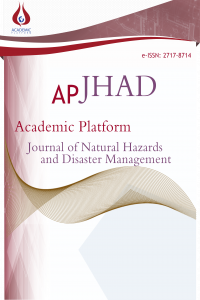Development of a Regional Numerical Tidal Forecast Model Along the Coast of Bangladesh and Its Associated Tidal Height Estimation
Development of a Regional Numerical Tidal Forecast Model Along the Coast of Bangladesh and Its Associated Tidal Height Estimation
Bangladesh Coast, FDM, Numerical, Tide,
___
- [1] H. Ahmad, “Coastal Zone Management Bangladesh Coastal Zone Management Status and Future Trends,” J Coast Zone Manag, 2019. https://www.walshmedicalmedia.com/open-access/bangladesh-coastal-zone-management-status-and-future-trends-18228.html (accessed Aug. 13, 2022).
- [2] H. Li et al., “Phenotypic responses of Spartina anglica to duration of tidal immersion,” Ecol. Res., vol. 26, no. 2, pp. 395–402, Dec. 2011, doi: 10.1007/s11284-010-0794-z.
- [3] L. P. Miller, C. M. Matassa, and G. C. Trussell, “Climate change enhances the negative effects of predation risk on an intermediate consumer,” Glob. Chang. Biol., vol. 20, no. 12, pp. 3834–3844, Dec. 2014, doi: 10.1111/gcb.12639.
- [4] S. Pincebourde, E. Sanford, and B. Helmuth, “An intertidal sea star adjusts thermal inertia to avoid extreme body temperatures,” Am. Nat., vol. 174, no. 6, pp. 890–897, Jul. 2009, doi: 10.1086/648065.
- [5] G. A. Pearson and S. H. Brawley, “Reproductive ecology of Fucus distichus (Phaeophyceae): An intertidal alga with successful external fertilization,” Mar. Ecol. Prog. Ser., vol. 143, no. 1–3, pp. 211–223, Nov. 1996, doi: 10.3354/meps143211.
- [6] B. R. Maricle and R. W. Lee, “Root respiration and oxygen flux in salt marsh grasses from different elevational zones,” Mar. Biol., vol. 151, no. 2, pp. 413–423, Oct. 2007, doi: 10.1007/s00227-006-0493-z.
- [7] M. S. Davies, M. Edwards, and G. A. Williams, “Movement patterns of the limpet Cellana grata (Gould) observed over a continuous period through a changing tidal regime,” Mar. Biol., vol. 149, no. 4, pp. 775–787, Feb. 2006, doi: 10.1007/s00227-006-0258-8.
- [8] H. Koch, “Desiccation Resistance of the Supralittoral Amphipod Traskorchestia Traskiana (Stimpson, 1857),” Crustaceana, vol. 56, no. 2, pp. 162–175, Jan. 1989, doi: 10.1163/156854089X00059.
- [9] C. A. Richardson, I. Ibarrola, and R. J. Ingham, “Emergence pattern and spatial distribution of the common cockle Cerastoderma edule,” Mar. Ecol. Prog. Ser., vol. 99, no. 1–2, pp. 71–81, 1993, doi: 10.3354/meps099071.
- [10] K. Kellmeyer and M. Salmon, “Hatching rhythms of Uca thayeri rathbun: Timing in semidiurnal and mixed tidal regimes,” J. Exp. Mar. Bio. Ecol., vol. 260, no. 2, pp. 169–183, Jun. 2001, doi: 10.1016/S0022-0981(01)00259-3.
- [11] M. A. Al Mohit, M. Yamashiro, N. Hashimoto, M. B. Mia, Y. Ide, and M. Kodama, “Impact assessment of a major river basin in Bangladesh on storm surge simulation,” J. Mar. Sci. Eng., vol. 6, no. 3, p. 99, Aug. 2018, doi: 10.3390/JMSE6030099.
- [12] M. A. Al Mohit and M. Towhiduzzaman, “A numerical estimate of water level elevation due to a cyclone associated with a different landfall angle,” Sains Tanah, vol. 19, no. 1, pp. 33–41, Mar. 2022, doi: 10.20961/stjssa.v19i1.56600.
- [13] G. C. Paul and A. I. M. Ismail, “Tide-surge interaction model including air bubble effects for the coast of Bangladesh,” J. Franklin Inst., vol. 349, no. 8, pp. 2530–2546, Oct. 2012, doi: 10.1016/j.jfranklin.2012.08.003.
- [14] G. C. Paul and A. I. M. Ismail, “Contribution of offshore islands in the prediction of water levels due to tide-surge interaction for the coastal region of Bangladesh,” Nat. Hazards, vol. 65, no. 1, pp. 13–25, Aug. 2013, doi: 10.1007/s11069-012-0341-z.
- [15] G. C. Paul, A. I. M. Ismail, and M. F. Karim, “Implementation of method of lines to predict water levels due to a storm along the coastal region of Bangladesh,” J. Oceanogr., vol. 70, no. 3, pp. 199–210, Mar. 2014, doi: 10.1007/s10872-014-0224-x.
- [16] G. D. Roy, “Inclusion of off-shore islands in a transformed coordinates shallow water model along the coast of Bangladesh,” Environ. Int., vol. 25, no. 1, pp. 67–74, Jan. 1999, doi: 10.1016/S0160-4120(98)00094-4.
- [17] H. Takagi, N. D. Thao, and M. Esteban, “Tropical Cyclones and Storm Surges in Southern Vietnam,” Coast. Disasters Clim. Chang. Vietnam Eng. Plan. Perspect., pp. 3–16, Jan. 2014, doi: 10.1016/B978-0-12-800007-6.00001-0.
- [18] K. Matsumoto, T. Takanezawa, and M. Ooe, “Ocean tide models developed by assimilating TOPEX/POSEIDON altimeter data into hydrodynamical model: A global model and a regional model around Japan,” J. Oceanogr., vol. 56, no. 5, pp. 567–581, 2000, doi: 10.1023/A:1011157212596.
- [19] M. M. Rahman, G. C. Paul, and A. Hoque, “Nested numerical scheme in a polar coordinate shallow water model for the coast of Bangladesh,” J. Coast. Conserv., vol. 17, no. 1, pp. 37–47, 2013, doi: 10.1007/s11852-012-0216-1.
- [20] G. D. Roy, “Estimation of expected maximum possible water level along the Meghna Estuary using a tide and surge interaction model,” Environ. Int., vol. 21, no. 5, pp. 671–677, Jan. 1995, doi: 10.1016/0160-4120(95)00078-Y.
- [21] C. McCammon and C. Wunsch, “Tidal charts of the Indian Ocean north of 15°S,” J. Geophys. Res., vol. 82, no. 37, pp. 5993–5998, Dec. 1977, doi: 10.1029/jc082i037p05993.
- [22] M. M. Rahman, A. Hoque, G. C. Paul, and M. J. Alam, “Nested Numerical Schemes to Incorporate Bending Coastline and Islands of Bangladesh and Prediction of Water Levels due to Surge,” Asian J. Math. Stat., vol. 4, no. 1, pp. 21–32, Dec. 2010, doi: 10.3923/AJMS.2011.21.32.
- Yayın Aralığı: Yılda 2 Sayı
- Başlangıç: 2020
- Yayıncı: Akademik Perspektif Derneği
The Situation of Combined Disasters Caused by Climate Change: Antalya
Designing an Online Typhoon Mitigation Program
Resti Tito VİLLARİNO, Maureen Lorence VİLLARİNO
Forest Fire Analysis with Sentinel-2 Satellite Imagery: The Case of Mati (Greece) in 2018
Deniz BİTEK, R. Cüneyt ERENOĞLU
Md. Abdul Al MOHİT, Md. TOWHİDUZZAMAN, Mossa Samima NASRİN, Shourov Kumar GHOSH
